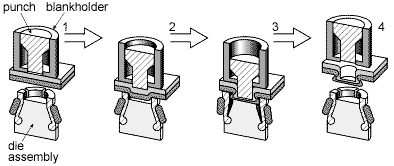|
 |
Fig.1. Schematic representation of the clinching operation |
Current status
Clinching is a fairly new technology, used mainly for high-volume, low specification applications. It is used for joining metal sheets of 0.5 to about 3mm in thickness, up to a total joint thickness of about 6mm. As the joint is made by local plastic deformation of the sheets, the materials should have sufficient ductility to avoid cracking. Clinching can be used on coated and painted materials, and is suitable for joining dissimilar materials. Typical materials that can be clinched include:
- low carbon and micro-alloyed steels
- zinc-coated, organic coated and pre-painted steels
- stainless steels
- lightweight materials, such as ductile aluminium alloys
Clinching is mainly used for joining steel sheet for white goods, heating and ventilating and automotive part manufacture. There, it replaces techniques such as resistance spot welding as well as the use of other mechanical fasteners, such as riveting.
Important issues
Clinching is a simple technique, with few important process variables. However, as clinching is mainly a proprietary technique, there are slightly different variations. This may give different properties, which are presently not very well documented.
Clinching forces are high, typically 20 to 70kN. This demands large stiff C-frames if a long reach machine is required. Some low force systems are available for semi-piercing clinch types, but lightweight equipment would be required for long reach robotic applications.
As many industries (e.g. automotive) are driven by weight-reduction, manufacturers are moving towards thinner and stronger materials. This may affect the ductility, impairing their suitability for clinching. This, however, may be overcome by further optimisation of the process cycle and punch and die design for specific materials and applications.
Benefits
The benefits of clinching include:
- Low cost, because low energy, single step process using no consumable
- Fast and easy automation
- Long tool life (typically 200,000+ joints)
- Possibility of making hybrid joints using adhesives
- Visual assessment of joint by checking button dimensions and in-process monitoring of force versus displacement
- Health & Safety implications are small, because clinching generates little noise, no fume and no heat
Risks
The operator risks of clinching are mainly from trapping hazards. However, this can in general be avoided by using two-handed or fully automated operation. Furthermore, because most systems are hydraulically powered, safety goggles should be worn.
| ◄back | |
| ▼home |